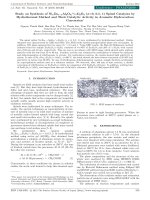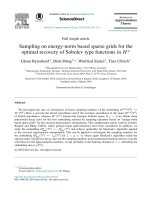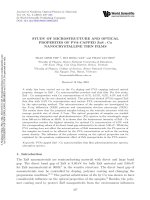DSpace at VNU: Study on current–voltage characteristics of OLEDs using Alq3 as the electron transport layer
Bạn đang xem bản rút gọn của tài liệu. Xem và tải ngay bản đầy đủ của tài liệu tại đây (330.72 KB, 7 trang )
VNU Jounal of science, Mathermatics - Physics 27 (2011) 174-180
Study on current–voltage characteristics of OLEDs using
Alq3 as the electron transport layer
Nguyen Kien Cuong*
Faculty of Engineering Physics & Nanotechnology, VNU University of Engineering & Technology (UET),
144 Xuan Thuy, Cau Giay, Hanoi, Vietnam
Received 10 September 2011, received and revised from 29 September 2011
Abstract. This paper describes changes in current-voltage (I-V) characteristic of an organic lightemitting device (OLED) stacked as a multilayer of ITO/MEH-PPV/Alq3/Al. The ordered, stacked
ITO/MEH-PPV/Alq3/Al multi-layers were fabricated by spin-coating and thermal vacuum
evaporation methods. First, dissolved MEH-PPV solution was spin-coated on ITO-electrodes that
had been covered on a glass-slide. Subsequently, an Alq3 layer was evaporated thermally on the
MEH-PPV-coated layer. Finally, an Al-electrode was evaporated also on the electron transport
layer. UV-vis absorption and photoluminescent characterization of the MEH-PPV and Alq3 layer
as well as their surface images were performed. All spectra obtained revealed the MEH-PPV and
Alq3 were deposited as given structure. The I-V characteristics show the present of the Alq3electron transport layer deposited between the MEH-PPV emissive layer and Al-cathode could
enhance current-voltage characteristic reducing the threshold voltage and turn-on voltage.
Keywords: UV-vis absorption, photoluminescence, electron transport layer, current-voltage
characteristics.
1. Introduction∗
Organic light-emitting devices (OLEDs) are composed of one or more thin layers of organic
materials sandwiched between two conductors. An applied potential across the contacts injects
electrons and holes from the cathode and anode, respectively. Then, a combination of holes and
electrons in an emissive layer would generate visible light.
In a well-designed device, there is a high probability of photon emission from the excited state, as
well as a balanced number of electrons and holes injected from both the cathode and anode,
respectively. However, in a conducting polymer used for a device, some defects exist in its chains. It
is these defects that are considered as traps to keep electrons and they prevent the electron mobility.
Hence, the hole mobility is usually much easier than the electron mobility inside the multilayer-OLED
devices. This effect usually causes unbalanced numbers between injected holes and injected electrons.
_______
∗
Tel. (+84) 982114032
Email:
174
N.K. Cuong / VNU Jounal of Science, Mathermatics - Physics 27 (2011) 174-180
175
Therefore, to resolve this problem, one of approaches is to enhance electron injection at the interface
of cathode/ electron transport materials (ETM) by using low work function metals [1-2] or introducing
a thin layer of electron injection material with high electron affinity between the cathode and ETM in
order to increase electron injection through stepwise injection from the cathode [3, 4]. Charge
injection balance is an extremely important issue in achieving high efficiency OLED devices. During
device operation, unbalanced injection of electrons or holes will result in non-irradiative
recombination of the charge carrier species at the organic/ cathode or the organic/anode interfaces [5].
For studying a device structure with charge-balanced operation, one needs to consider both the effect
of the energy barriers on charge injection and the effect of e/h mobility on charge transport.
Aluminum tris (8-hydroxyquinoline) (Alq3) is a thermally stable, highly fluorescent material with
excellent electron-transport mobility. A limitation associated with Alq3 is its poor process-ability
because the Alq3 layer must be vacuum-deposited. However, the addition of the Alq3 layer between an
emissive layer and a cathode electrode could enhance a number of injected electrons arriving at the
interface of the emissive/Alq3 layer.
In this paper, we have reported changes in current-voltage (I-V) characteristics of the organic
light-emitting devices (OLED) based on the structures of MEH-PPV monolayer (ITO/MEH-PPV/Al)
and bilayers MEH-PPV/Alq3 (ITO/MEH -PPV/Alq3/Al). The difference of current intensity, and turnon voltage corresponding the MEH-PPV monolayer and MEH-PPV/Alq3 bilayer as well as effects of
these characteristics on performance and luminescent efficiency were studied.
2. Experiments
Organic small molecules, Alq3, and conducting polymer, poly(2-methoxy-5-(2’-ethyl-hexyloxy)-pphenylene vinylene) (MEH-PPV), ITO-covered glass-slides as well as toluene solvent were purchased
from Aldrich-Sigma Co. Ltd. Molecular structures of MEH-PPV and Alq3 substances are shown in left
side and right one of the figure 1, respectively. A single polymer-monolayer (ITO/MEH-PPV/Al) and
polymer-bilayer (ITO/MEH-PPV/Alq3/Al) of the OLED device were fabricated using the corrosion
method creating ITO-electrodes, subsequently the spin-coating and thermal vacuum-evaporation
techniques to deposit the MEH-PPV and Alq3 layers, respectively. Finally, Al-electrodes were
thermally vacuum-evaporated on the polymers to make a single-layer and bilayer devices.
Fig. 1. The structure of MEH-PPV (left) and Alq3 (right).
176
N.K. Cuong / VNU Jounal of Science, Mathermatics - Physics 27 (2011) 174-180
First, used as anode-electrodes of OLED devices, an ITO-deposited glass-slide was cut into pieces
of 10 x 10 mm. A part of ITO-layers was then marked, avoiding to be corroded, with the solution
composed of nitrocellulose, and the rest of them (without the mark) was corroded by the mixed
solution of HCl: H2O: HNO3 response to 4:2:1 ratio, respectively. Finally, the marked layer on the
ITO-layer was removed in sonicated acetone-solution for 30 min. The ITO-electrodes on the glass
pieces (so-called samples) were cleaned in de-ionized water, and dried in an oven.
Prior to spin-coating to fabricate a film, the solution of MEH-PPV dissolved in toluene at a rate of
2mg/ml. Stirred in 10 min., subsequently dispersed in an ultrasonic bath for about 30 min., a MEHPPV-layer was spin-coated on the ITO-anode at a speed of 1300 rpm for 1min., then baked in vacuum
oven at 800C for 30min.
Playing a role of the electron transport layer, Alq3 was deposited on the MEH-PPV layer by
thermal vacuum evaporation of Alq3 powder for 90s in a chamber of the thermal vacuum-evaporation
coater. The sample was then taken out of the chamber after its temperature cooled down to room one,
avoiding sample's surface oxidation.
Fig. 2a. SEM micrographs showing some aggre-gated molecules on the surface of the MEH-PPV film.
Similarly, the Al-electrode served as the cathode was deposited on the Alq3-layer by thermal
vacuum-evaporation of an Al pure wire at a chamber pressure of about 10-4 Torr for 90s. The thickness
of the Al-cathode layer was estimated about 80 nm. This value is also equal to the thickness, measured
by a surface profiler KLA-Tencor α-step at the scan length of 10nm and scan speed of 2 mm/s.
Fig. 2b. SEM micrograph showing rough, well-uniformed surface of the thermally evaporated Alq3 layer.
N.K. Cuong / VNU Jounal of Science, Mathermatics - Physics 27 (2011) 174-180
177
Besides, the MEH-PPV and Alq3 layer was also fabricated for optical characterization of each
layer. Images of the deposited layers were identified by observing them on an ultra high resolution
scanning electron microscope (FE-SEM), a model Hitachi S-4800. UV-vis adsorption and luminescent
emission properties of each layer were determined by a UV-vis/NIR spectrophoto-meter (model Jasco
V-570) at the bandwidth of 1.0 nm, a scanning speed of 200nm/min. and within the range of 200-800
nm. Photoluminescent emission of MEH-PPV and Alq3 layers was performed with the excitation at a
wavelength of 325 nm at the room temperature. And also, electronic transport in the ITO/MEHPPV/Alq3/Al devices was studied via current-voltage (I-V) curves taken using a 2400 Keithley source
meter by sourcing voltage across the ITO (positive) and Al (negative) electrodes and measuring the
resulting current.
3. Results and Discussion
Spin-coated MEH-PPV and thermally evaporated Alq3 layers were identified by observing their
images on the SEM. As can be seen, the surface of the spin-coated layer is rather well-uniformed with
some MEH-PPV clusters (high molecular density). It might be attributed to the dissolved polymer,
which was accumulated due to the solvent’s evaporation itself, causing it’s viscosity during the spincoating process. Hence, the MEH-PPV molecules were hardly uniformly dispersed on the ITO surface.
1
1. Alq 3
2. MEH-PPV
2
Fig. 3. Typical UV-Vis absorption spectra of Alq3 (1) and MEH-PPV (2) thin films deposited on glass-slides.
Not similar to the surface of the MEH-PPV layer, the SEM micrograph revealed the rough and
well-uniformed surface of the thermally-evaporated Alq3-layer which can enhance the contacted
surface area between the Alq3 layer and the Al-electrode. This might be a factor that could improve the
electron injection from the Al-cathode to the electron transport layer.
178
N.K. Cuong / VNU Jounal of Science, Mathermatics - Physics 27 (2011) 174-180
1. Alq 3
2. MEH-PPV
PL Intensity (a.u.)
1
2
400
500
600
700
800
900
Wavelength (nm)
Fig. 4 Photoluminescent spectra of Alq3 (1) and MEH-PPV (2) excited by a laser at the wavelength of 325 nm.
Absorbance peaks of MEH-PPV and Alq3 (in Fig. 3) were located at the wavelength of 543 nm
and 387 nm, respectively. Their peak-absorbance was in a near- and visible region. These peaks are
rather similar to those reported by Djurisic et al. [6]. Moreover, It is obvious that the absorption peaks
at about 387 nm originate from the π to π* transition of organic backbone of Alq3. The absorption
peak is in a good agreement with the absorption valuation reported by X. Chunxiang et al. [7]. Based
on the UV-Vis peak absorbance of both polymers, the excitation of the wavelength of 325nm,
generated by a He-Cd laser source, was selected for the photoluminescent characterization.
Photoluminescent spectra of both polymers with the excitation of the wave length of 325 nm for
MEH-PPV- and Alq3-polymer film were shown in Fig. 4. The peak emitted of Alq3 was found at 517
nm [7] while the emission peak of MEH-PPV was located at 587 nm with a shoulder at 635 nm at RT.
These spectra, being a good evidence of the polymers deposited on each other, are suitable to those
being reported by Reddy et al.[8, 9]
The I-V characteristics of the single layer device (ITO/MEH-PPV/Al) and the bilayer-device
(ITO/MEH-PPV/Alq3/Al) were shown in Fig. 5. . The simplest I -V characteristic involves a resistor,
which according to Ohm's Law exhibits a linear relationship between the applied voltage and the
resulting electric current. However, depending on characteristics of the conducting polymers
sandwiched between two electrodes, the device's resistor can produce non-linear curve exhibiting
diode-like behavior.
For the MEH-PPV monolayer device (ITO/ MEH-PPV/Al), the MEH-PPV served as a holetransport layer. As the hole-mobility is much greater than the electron-one, and due to the mobility
imbalance, hence running through the MEH-PPV, a number of hole accumulated at the interface of the
polymer and Al-electrode. It resulted in the light-emission region located near the Al-cathode, and in
the low resistor. Therefore, the I-V curve of the MEH-PPV monolayer diode shows a large value of
the turn-on voltage, and low current intensity when the voltage was over the value of 1.7 -1.8 V.
N.K. Cuong / VNU Jounal of Science, Mathermatics - Physics 27 (2011) 174-180
179
Current Intensity (mA)
Not similar to single layer device, for the (ITO/MEH-PPV/Alq3/Al) bilayer device with Alq3 layer
served as an electron transport one, the light-emission region would be located near the MEHPPV/Alq3 interface. Because the HOMO (highest occupied molecular orbit) level of Alq3 (5.9 eV) lay
down lower than that of MEH-PPV (see Fig. 6) and in Alq3 the electron mobility is superior to the
hole one. Thus, Alq3 layer served as an effective hole broker, it is difficult for holes to cross the Alq3
layer.
1. ITO/MEH-PPV/Al
2. ITO/MEH-PPV/Alq3/Al
2
1
Fig. 5. Current-voltage characteristics of (1) the (ITO/MEH-PPV/Al) monolayer device & (2) the (ITO/MEHPPV/Alq3/Al) bilayer device .
Moreover, in the bilayer device, the Alq3 layer was thicker than the MEH-PPV one, so holes could
be accumulated near the MEH-PPV/Alq3 interface until electrons arrived. Therefore, the I-V
characteristics of the MEH-PPV/Alq3 bilayer device demonstrate a larger value of the turn-on voltage
(1.7-1.8 V), and higher current intensity than these values of the MEH-PPV monolayer device.
Moreover, the I-V curve of the bilayer device looks more identical to that of a diode in comparison
with the I-V curve of the single-layer device (Fig. 5). This might be attributed to increase in the
resistor due to the deposition of Alq3 of the bilayer devices that demanded a larger turn-on voltage.
And also, the Alq3 layer adjacent to the Al cathode acted as an electron-transporting layer that can also
prevent excitons quenching close to the cathode. However, a number of holes and electrons that could
be recombined at the interface of MEH-PPV/Alq3 bilayer, considerably increased. It resulted in the
enhancement of luminescent efficiency and the lifetime of the ITO/MEH-PPV/Alq3/Al device.
Fig. 6 Barrier energy at HOMO-LUMO level of MEH-PPV and Alq3.
180
N.K. Cuong / VNU Jounal of Science, Mathermatics - Physics 27 (2011) 174-180
4. Conclusions
The addition of the Alq3 electron-transport layer sandwiched between Al-cathode and MEH-PPV
by the thermal vacuum evaporation have improved the current-voltage characteristics of OLEDs based
on the bilayer structure (ITO/MEH-PPV/Alq3/Al). The I-V curve of the bilayer device demonstrated
diode-behavior while the curve of the monolayer device revealed a resistor behaviour only. This could
be ascribed to Alq3 serving as the hole-blocking that improved the balance of electron and hole
current. It resulted in stability and luminescent efficiency of the OLEDs.
Acknowledgments
The author would like to thank the strong support and financial aids of Vietnam national
University, Hanoi for the QG.10.42 project in the 2010-2012 academic years. My gratitude is also
extended to Professor Nguyen Nang Dinh, Faculty of Engineering Physics & Nanotechnology for
useful discussion on charge mobility through hetero-junction of MEH-PPV- and Alq3-layers. Thanks
are also extent to the BSc Van Trong Nghia, a former student of the Faculty Engineering Physics &
Nanotechnology, UET-VNU, Hanoi for the sample preparation and providing SEM’s micrographs.
References
[1] M. G. Mason, C. W. Tang, L. S. Hung, P. Raychaudhuri, J. Madathil, D. J. Giesen, L. Yan, Q. T. Le, Y. Gao, S.
Y. Lee, L. S. Liao, L. F. Cheng, W. R. Salaneck, D. A. d. Santos, and J. L. Bredas, Interfacial chemistry of Alq
and LiF with reactive metals, J. Appl. Phys. 89 (2001) 2756.
[2] X. Y. Deng, S. W. Tong, L. S. Hung, Y. Q. Mo, and Y. Cao, Role of ultrathin Alq and LiF layers in
conjugated polymer light-emitting diodes, Appl. Phys. Lett. 82 (2003) 3104.
[3] Y. Yang and Q. Pei, Electron injection polymer for polymer light-emitting diodes, J. Appl. Phys. 77 (1994)
4807.
[4] T. Kanbara, T. Yamamoto, K. Ishikawa, H. Takezoe, and A. Fukuda, Polyquinoxaline as an excellent electron
injecting material for electroluminescent device, Appl. Phys. Lett. 68 (1996) 2346.
[5] V. Bulovic, V. B. Khalfin, G. Gu, P. E. Burrows, D. Z. Garbuzov, & S. R. Forrest, Weak microcavity effects in
organic light-emitting devices, Phys. Rev. B 58 (1998) 3730.
[6] A.B. Djurisic, T.W. Lau, L.S.M. Lam, W.
K. Chan, Influence of atmospheric
exposure of tris (8hydroxyquinoline) aluminum (Alq3) a photoluminescence and absorption study. Appl. Phys. A, 78 (2004) 375.
[7] X. Chunxiang, X. Qinghua, Z. Yuan, C. Yiping, B. Long, B. Zhao and Ning Gu, Photo-luminescent blue-shift
of organic molecules in nanometre pores, Nanotechnology 13 (2002) 47.
[8] Anver Aziz, K.L. Narasimhan, Subband gap optical absorption and defects in Tris(8 hydroxy quinolato)
aluminium, Synthetic Metals 131 (2002) 71.
[9] V.S. Reddy, A. Dhar, Optical and charge carrier transport properties of polymer light emitting diodes based on
MEH-PPV, Physica B 405 (2010) 1596.
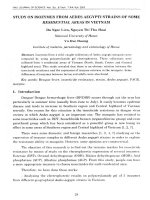
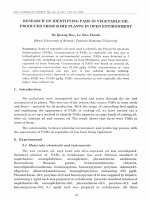
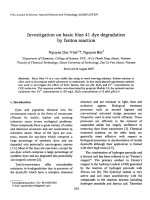
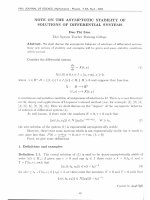

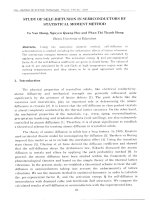
![DSpace at VNU: Corrigendum to ‘‘Nonlinear dynamic response of imperfect eccentrically stiffened FGM double curved shallow shells on elastic foundation’’ [Compos. Struct. 99 (2013) 88–96]](https://media.store123doc.com/images/document/2017_12/14/medium_vrh1513028470.jpg)
